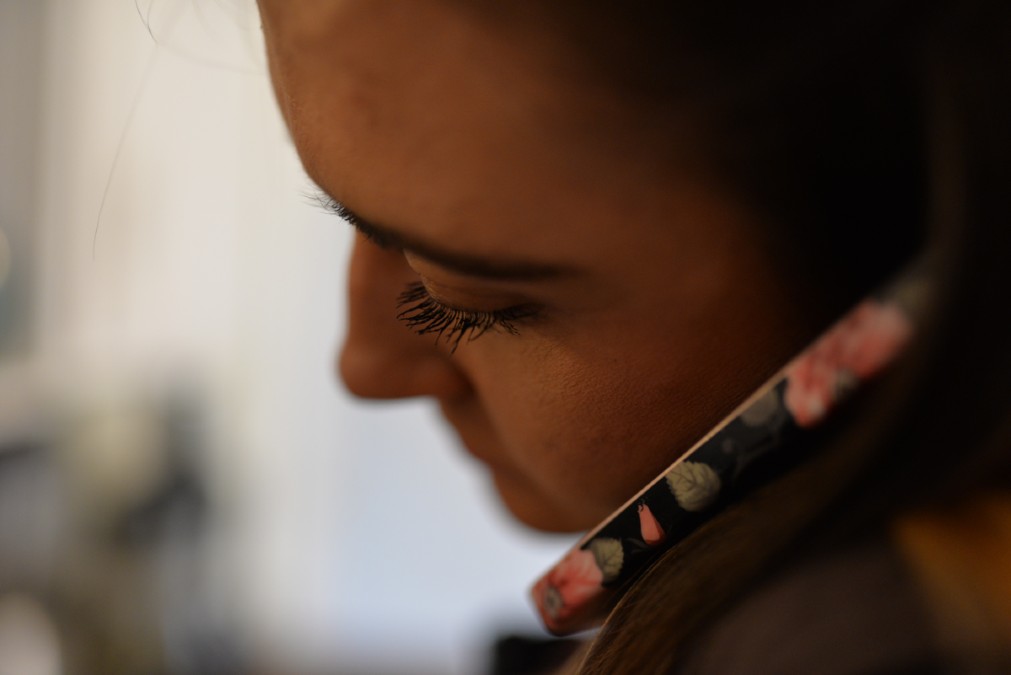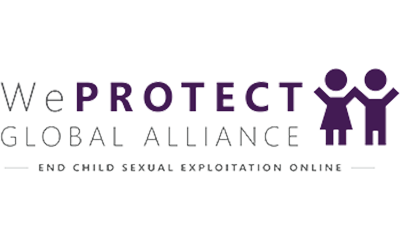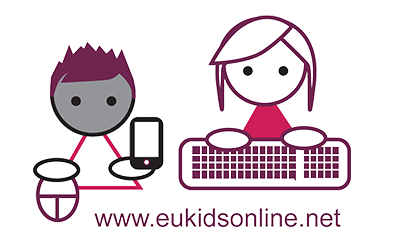Most children spend at least three hours online on a week day
Most of the surveyed children from Serbia use the internet on a daily basis (86%). Two-thirds (65%) of the youngest children (9-10 years) and almost all older children (98%, 15-17 years) go online using a mobile phone. On average, children spend more than three hours per day online with older children spending up to four and a half hours. On weekends, two-thirds of children spend between four and seven hours and more than a fifth spend up to seven hours browsing the internet. Given the multiple functions that digital devices have in the lives of today’s youth, time spent online is not necessarily an indicator for problematic use. The quality of the time and the type of internet activity are much more important.
Children rarely use the internet for creative activities
Children in Serbia use the internet mainly to engage in leisure activities, such as listening to music (80%) and watching videos (78%), to use social media (74%), to talk to family or friends (67%), or to play games (53%). More than two-thirds of children (74%) have a profile on some social networking or gaming platform. This is equal to 41% of 9-10-year olds and 72% of 11-12-year olds having a profile, although the minimum age set by social networking sites is usually 13 years. Other online activities are much less common. Less than half of children (40%) use the internet for school assignments at least once a week. Large majorities never join a campaign or sign a petition online (88%), never discuss political or social issues online (79%) and never use the internet for creative purposes, to share content they have produced (60%).
Children who spend more time online have better digital skills
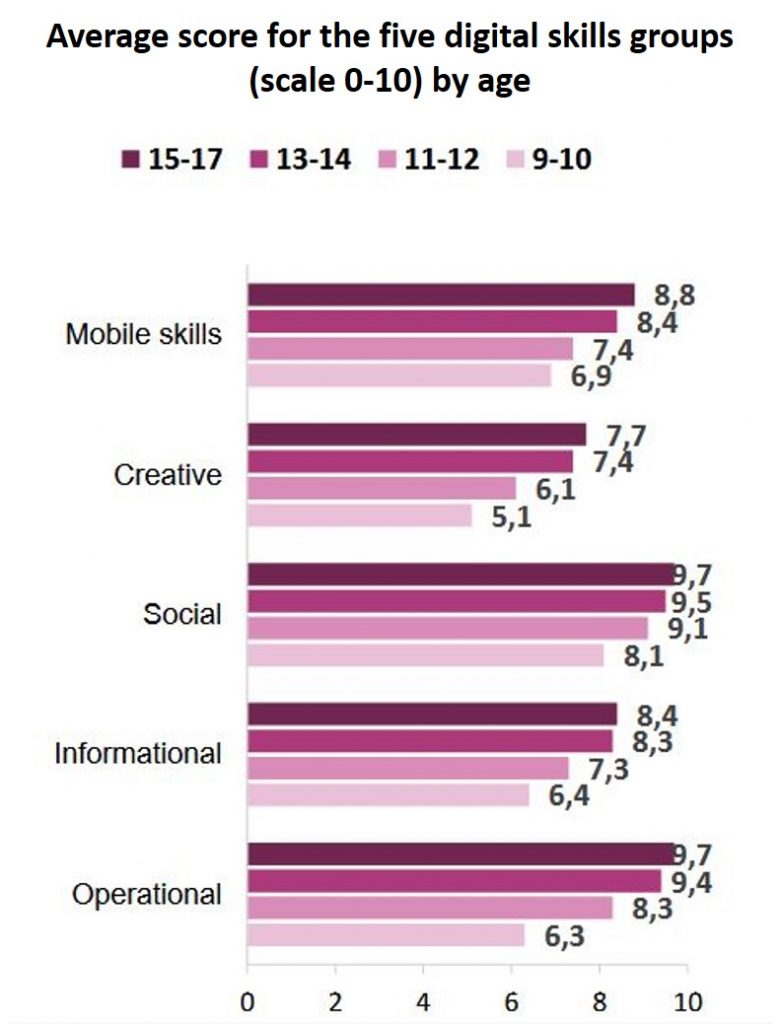 The average score for the five groups of digital skills (creative, information seeking, mobile use, operational, and social) ranges from 6.7 to 8.6 (on a scale of 0 to 10). The lowest average score is for content creation skills (6.7), followed by information seeking and browsing skills (7.7), mobile use (8.0), operational skills (8.6), while the highest average score is for social skills (9.2). Based on self-assessment, boys have better information, content creation and mobile skills compared to girls and older children are generally doing better than their younger peers. The majority of children find it easy to know if the information they found online is true (72%) and to know if the information is trustworthy (68%). While 92% of children know how to install an application on a mobile phone, just over half (53%) know how to keep track of the cost of using the application. About half of the younger and about two-thirds of the older children know how to make a video or music and post it online. Fewer children say they know how to modify content created and uploaded by others (one fifth of younger and less than a half of older students). Hence, Serbian children are users of internet content more often than they are creators and many of them do not take advantage of the full range of online opportunities.
The average score for the five groups of digital skills (creative, information seeking, mobile use, operational, and social) ranges from 6.7 to 8.6 (on a scale of 0 to 10). The lowest average score is for content creation skills (6.7), followed by information seeking and browsing skills (7.7), mobile use (8.0), operational skills (8.6), while the highest average score is for social skills (9.2). Based on self-assessment, boys have better information, content creation and mobile skills compared to girls and older children are generally doing better than their younger peers. The majority of children find it easy to know if the information they found online is true (72%) and to know if the information is trustworthy (68%). While 92% of children know how to install an application on a mobile phone, just over half (53%) know how to keep track of the cost of using the application. About half of the younger and about two-thirds of the older children know how to make a video or music and post it online. Fewer children say they know how to modify content created and uploaded by others (one fifth of younger and less than a half of older students). Hence, Serbian children are users of internet content more often than they are creators and many of them do not take advantage of the full range of online opportunities.
Every third child is bothered by something online
A third of all children reported being upset by something online over the past year and for half of them it happened more than once. When upset by something online children most often turn to their friends (45%) or parents (31%) but a quarter do not speak to anyone about it. Other strategies include ignoring the problem thinking that it will go away by itself (23%), closing the window or application (25%), or blocking the person (31%). The number of children who frequently have disturbing experiences is the highest amongst the 13-14 years age group.
Bullying online and face to face are almost equally common – 16% of children experience cyberbullying and 15% experience bullying in person with a third of children being both victims and perpetrators of cyberbullying.
Between 13% and 51% of children, depending on the type of behaviour, engage in some other type of risky activities online. Most often, this involves sharing personal information, contacting unknown people online and sometimes meeting them in person, or hiding behind a false identity. A quarter of children (slightly more boys than girls) have met in person someone they got to know online but for the most this is a pleasant experience, even though 9% of children report being upset by such meeting. Between a third and half of children aged 11-17 years are exposed to various types of harmful online content with older children and girls being at a higher risk. Slightly less than half of the children have seen gory or violent images (45%), ways of physically harming or hurting themselves (47%), hate messages that attack certain groups or individuals (45%); about a third have seen content about ways to be very thin (38%), taking drugs (35%), or ways of committing suicide (31%).
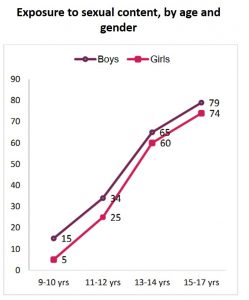 Every other student encounters sexual content, significantly more frequently online than in print media. Exposure to this type of content is more prevalent among older children, so three-quarters of children aged 15-17 years come across such content compared to one in ten children aged 9 to 10 years. Almost a third of children aged 11-17 have visited a pornographic website over the course of the past year. While younger children are more upset to come across sexual content, for the majority of children this is not a negative experience. A quarter of students (26%, 11-17 years old) have received a sexual message in the past year with boys and older children being more likely to receive such content. The proportion of children who have sent such messages is much smaller (8%).
Every other student encounters sexual content, significantly more frequently online than in print media. Exposure to this type of content is more prevalent among older children, so three-quarters of children aged 15-17 years come across such content compared to one in ten children aged 9 to 10 years. Almost a third of children aged 11-17 have visited a pornographic website over the course of the past year. While younger children are more upset to come across sexual content, for the majority of children this is not a negative experience. A quarter of students (26%, 11-17 years old) have received a sexual message in the past year with boys and older children being more likely to receive such content. The proportion of children who have sent such messages is much smaller (8%).
Parents offer more support to younger children and girls
The younger the children, the more the adults are expected to mediate their use of digital technology and the internet. Parental mediation is primarily aimed at protecting children’s safety online and preventing negative experiences and much less at enabling children to take advantages of the opportunities offered by digital technology use.
Less than half of the children (9-17 years old) say that their parents often explain to them how to use the internet safely (44%) or help them when something bothers them online (41%). About a third of children talk to parents often about what they do online (35%) or how to use the internet to seek information and learn (29%), but one in three children (30%) never or rarely does so. Parents are more aware and more likely to mediate girls’ than boys’ activities. Even in the younger age group (9-12 years), more than half of children regularly offer help to their parents to do something online and the proportion is even higher for older children.
Similarly to parents, teachers do not encourage children enough to use the internet in a meaningful way. Less than a third of children often receive encouragements from teachers to explore and learn using digital devices (28%), a third say that teachers do this only occasionally and another third (30%) that teachers never or almost never encourage them to use digital technology in this way. Only 3% of children seek support from their teachers when they experience something upsetting online.
Only a fifth of children are encouraged by friends to research and learn online, receive help from their peers when they are troubled by something online, or receive guidance on how to use the internet safely. However, after a negative online experience, almost half of the children turn to a friend to talk about what happened.

